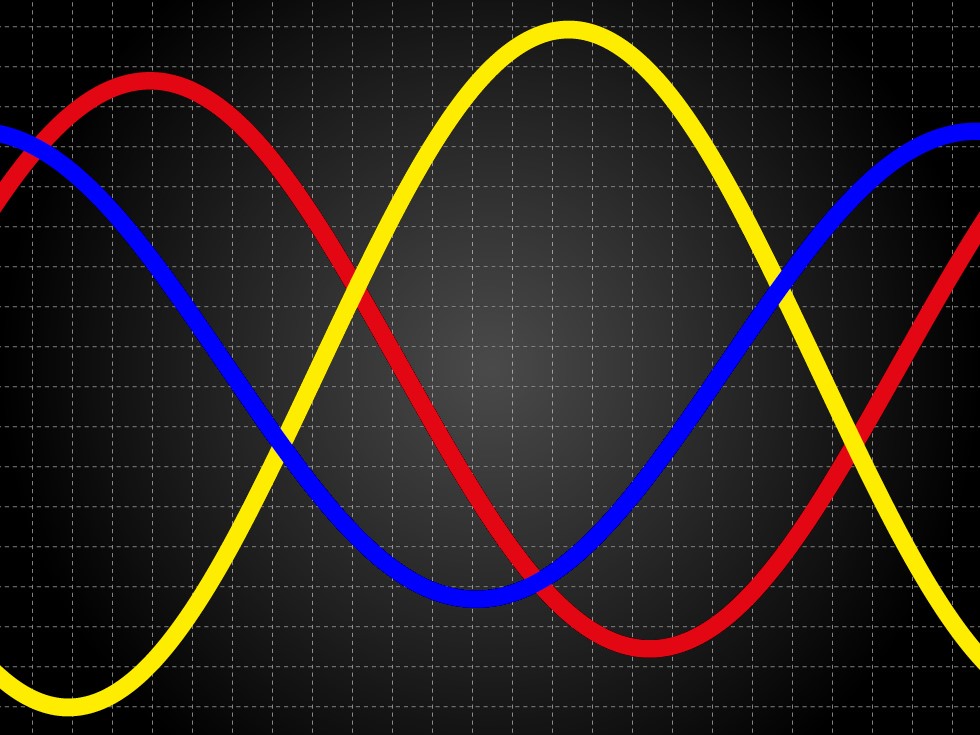
A precise single-phase or three-phase supply with optimum phase symmetry in terms of amplitude and phase position is of considerable importance for certain tests. If one – or even both – conditions are not fulfilled, this can lead to significant mismeasurements and in the worst case even to an incorrect GO/NOGO assessment.
With our 6 selection criteria, everyone can find the right test voltage source:
Criteria:
1 fixed or variable test voltage?
2 low or high voltage stability?
3 fixed or variable frequency?
4 low or high phase symmetry?
5 exact phase shifting of 120° between the 3 phases?
6 low distortion/bias – harmonic waves?
For all these challenges different solutions are possible – which differ in technical complexity and accordingly in price – see also our overview at the end of this text.
What unbalances occur in the three-phase grid?
1. Unbalanced phase voltages
In the grid supply, the voltage differences between the 3 phases may be several percent.
2. Unbalanced phase angle between the phases
The deviation in the phase angle of the 3 phases to each other should also not be underestimated. Ideally it should be 120° electric. But even a few tenths of a degree of phase difference from the ideal value can have a significant effect on the current consumption or the cos φ of the test object.
This is particularly true for electrical machines.
3. Distortions / Harmonic waves
Depending on their severity, these influences also have an impact on the audit, but are not considered in this text.
What effects do unbalances have on a test result?
Unbalanced phase amplitudes and/or phase shifts can lead to considerable differences in current consumption in the individual or linked phases.
Naturally, phase asymmetries always exist in the real network – as a result, of course, the described effects will always be present. …
For testing purposes, on the other hand, a high degree of symmetry in terms of amplitude and phase position is often necessary in order to reliably detect certain error effects in the first place. As an example of high symmetry, the no-load current consumption or locked rotor testing of asynchronous machines can be considered.
Ohmic, inductive or capacitive devices under test
Virtually all test objects can be reduced to one of the 3 basic variants or mixtures of these 3 variants in terms of the power supply and the directly associated current consumption.
This typically affects the phase shift between voltage and current.
Purely ohmic devices under test
Typical examples are electric heat generators, consisting of resistors.
Since they are purely ohmic in nature, voltage and phase asymmetries can be mathematically corrected relatively easily. The current has no phase shift in relation to the voltage, which means that power measurements are also possible despite the unbalance.
Inductive, capacitive devices under test
Examples of typical applications are electric motors, compensations, etc.
The interrelationships and effects are definitely more complex in this case and cannot be compensated mathematically so easily due to the many influences present. In theory, compensation is always possible – but in practice, many parameters of components such as inductances, leakage inductances, capacitances and couplings of components to each other are unknown factors.
At least at this stage a reliable balanced voltage supply is necessary.
SCHLEICH voltage sources for an optimal test voltage
| Test voltage supply | driectly from the grid | Variable transformer | Variable transformer with phase control | Variable transformer with control per phase plus fine offset per phase | Frequency converter | Frequency converter plus fine offset per phase |
electronic source | |
| Variable test voltage | – | + | + | + | + | + | + | |
| Voltage balance | – | – | + | ++ | ++ | +++ | ++++ | |
| Fast voltage fluctuation | – | – | – | + | ++ | ++ | ++++ | |
| Slow voltage fluctuation | – | + | + | +++ | +++ | +++ | ++++ | |
| 120° Phase symmetry | – | – | – | – | +++ | +++ | ++++ | |
| Variable output frequency | – | – | – | – | +++ | +++ | ++++ | |
| Distortion harmonic waves | – | – | – | – | ++ | ++ | ++++ | |
| Costs | ++++ | +++ | ++ | + | + | – | –– | |
| Rating | sufficient |
satisfactory |
satisfactory |
good |
good |
very good |
very good |
|
| Summary | for tests with fixed voltages but without any claim to stability | variable voltages | variable voltages with good symmetry | variable voltage with top symmetry | top variable voltage and frequency | close to optimal variable voltage and frequency |
perfect, but expensive variable voltage, frequency and phase position |
